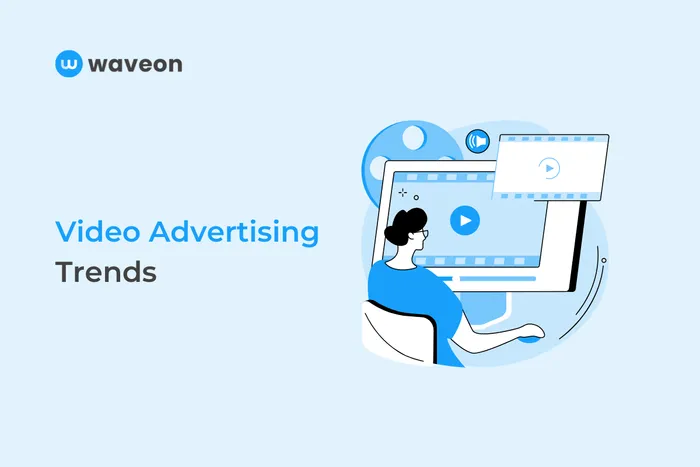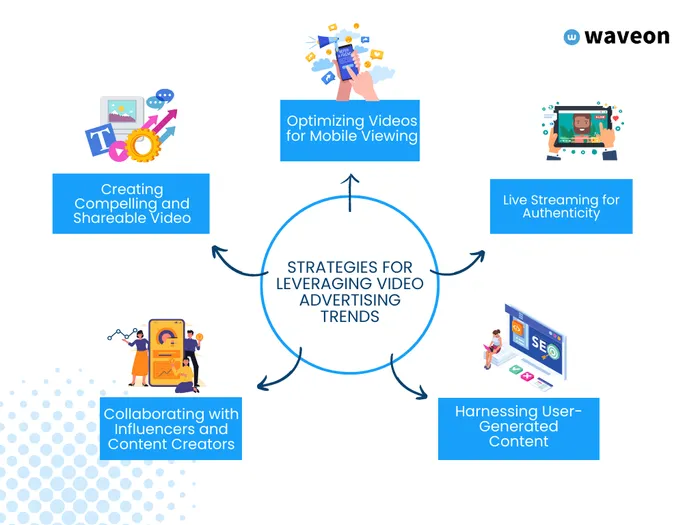Insight
Video Advertising Trends: Leveraging the Rise of Video Consumption
Waveon Team
7/6/2023
0 min read
TABLE OF CONTENTS

Introduction
Video advertising has emerged as a powerful tool in the digital landscape, allowing brands to engage and captivate audiences in compelling ways. With the rapid rise of video consumption, it has become essential for marketers to leverage these trends and make the most of this dynamic medium. This article explores the current landscape of video consumption, key trends in video advertising, benefits and challenges, strategies for leveraging these trends, case studies of successful campaigns, and a glimpse into the future of video advertising.
Current Landscape of Video Consumption
In recent years, video consumption has experienced exponential growth. Audiences are increasingly turning to platforms such as YouTube, social media, and streaming services to consume video content. According to statistics, video content is expected to account for 82% of global internet traffic by 2023. Mobile video consumption, in particular, has skyrocketed, thanks to the widespread availability of smartphones and improved internet connectivity.
Key Trends in Video Advertising
1. Short-Form Video Content : Short-form video platforms like TikTok and Instagram Reels have gained tremendous popularity. Marketers are leveraging these platforms to create snackable, visually appealing ads that resonate with younger audiences.
2. Live Streaming and Interactive Video Ads : Live streaming has become a powerful tool for brands to connect with their audiences in real-time. Interactive video ads, where viewers can engage with the content, provide a more immersive and engaging experience.
3. Personalization and Targeted Advertising : With advanced data analytics and targeting capabilities, marketers can deliver personalized video ads tailored to individual preferences and demographics. This approach increases relevancy and boosts engagement.
4. Influencer Marketing and Branded Content : Collaborating with influencers and content creators has become a prevalent strategy in video advertising. By integrating products or services seamlessly into authentic content, brands can tap into the influencer's engaged audience and build trust.
When it comes to video advertising, it's also important to find a video editing tool that everyone can use. Whether you are new to editing videos or someone who has years of experience, the right tool can do wonders with the quality of produced videos. Some video editors don't only come with basic features such as removing noise from video, adding music and text to video, and different video effects.
They have stepped up the game and offer additional features such as an AI image generator, Instagram downloader, voice recorder, and GIF to video converter. Any business can take advantage of these changes to maximize the benefits they can get through video advertising.
5. Connected TV Advertising : As viewers increasingly shift from traditional TV to connected TV devices, brands are embracing this trend by advertising on streaming platforms and leveraging data-driven targeting to reach their desired audiences.
Benefits and Challenges of Video Advertising
Benefits:
High Engagement: Videos have the ability to capture attention quickly and hold viewers' interest, leading to higher engagement rates compared to other forms of content.
Visual Storytelling: Videos allow brands to tell compelling stories visually, evoking emotions and creating a stronger connection with the audience.
Increased Conversions: Video ads can drive higher conversion rates, as they effectively communicate product features and benefits, leading to more informed purchase decisions.
Brand Awareness: Engaging videos can leave a lasting impression on viewers, enhancing brand recall and awareness.
Versatility: Video advertising can take various forms, from short ads for social media to longer-form content like tutorials, interviews, and behind-the-scenes glimpses.
Mobile-Friendly: With the rise of mobile device usage, video ads are easily consumable on smartphones and tablets, enabling brands to reach users on-the-go.
Social Media Compatibility: Video content is highly shareable and performs well on social media platforms, amplifying reach and potential virality.
Challenges:
Production Costs: Creating high-quality videos can be costly, especially for businesses with limited budgets. Factors like equipment, professional editing, and talent contribute to expenses.
Attention Span: With short attention spans, capturing and retaining viewer interest within the first few seconds is crucial. Failing to do so can result in disengagement.
Platform Constraints: Different platforms have varying video length limits and formatting requirements. Adapting videos to suit each platform can be time-consuming.
Competition: The popularity of video advertising has led to increased competition for viewers' attention. Brands must create standout content to rise above the noise.
Creative Strain: Continuously generating fresh and innovative video ideas can be challenging, leading to potential creative burnout.
Message Clarity: Condensing a message into a short video while maintaining clarity and impact can be tricky, potentially leading to miscommunication.
Viewability and Ad Blocking: Ensuring videos are viewable by the right audience and combating ad-blocking software can impact the effectiveness of video campaigns.
Strategies for Leveraging Video Advertising Trends
In order to harness the power of video advertising and leverage the ongoing trends in the industry, brands can employ several effective strategies. These strategies enable brands to create impactful video campaigns that resonate with their target audience and maximize their return on investment. Here are some key strategies for leveraging video advertising trends:
1. Creating Compelling and Shareable Video Content
a. Storytelling: Craft a compelling narrative that engages viewers emotionally and creates a connection with the brand. A well-told story can evoke emotions, inspire action, and leave a lasting impression.
b. Visual Appeal: Invest in high-quality visuals, including eye-catching graphics, stunning cinematography, and appealing aesthetics. Visuals play a significant role in capturing viewers' attention and conveying the brand's message effectively.
c. Conciseness: Keep videos concise and to the point. With shorter attention spans, viewers are more likely to engage with videos that deliver the message efficiently and without unnecessary fluff.
d. Call-to-Action: Include a clear call-to-action in the video that prompts viewers to take the desired action, whether it's visiting a website, subscribing to a channel, or making a purchase. A strong call-to-action enhances the effectiveness of video advertising campaigns.
2. Optimizing Videos for Mobile Viewing
a. Vertical Video Format: Design videos specifically for vertical viewing to accommodate the natural way users hold their smartphones. Vertical videos maximize screen real estate and provide a seamless viewing experience on mobile devices.
b. Quick Start: Grab viewers' attention within the first few seconds to prevent them from scrolling past the video. Engaging visuals, captivating hooks, or intriguing questions can help hook viewers from the start.
c. Subtitles and Captions: Incorporate subtitles or captions in videos to cater to viewers who watch videos without sound or have hearing impairments. This accessibility feature improves engagement and ensures that the message is conveyed effectively.
3. Harnessing User-Generated Content
User-generated content (UGC) can be a powerful tool in video advertising. It not only provides authentic and relatable content but also encourages engagement and builds a sense of community around the brand. To leverage UGC
a. Encourage User Participation: Encourage users to create and submit videos related to the brand or its products/services. This can be in the form of challenges, contests, or testimonials. User participation boosts brand loyalty and extends the reach of the video campaign.
b. Curate and Showcase UGC: Identify and curate the best user-generated videos to showcase on brand-owned channels. This demonstrates the brand's appreciation for its customers and strengthens the relationship between the brand and its audience.
4. Live Streaming for Authenticity
Live streaming is on the rise, with live videos garnering significantly higher engagement rates compared to pre-recorded content. Live streams provide an authentic and interactive connection with audiences.
Brands can leverage live streaming for product launches, behind-the-scenes glimpses, Q&A sessions, and more. The real-time interaction fosters a sense of community and authenticity, resonating well with consumers.
5. Collaborating with Influencers and Content Creators
Influencer marketing and collaborations with content creators have become integral to successful video advertising campaigns. By partnering with influencers and content creators, brands can tap into their established audiences and benefit from their credibility and authenticity. Consider the following strategies:
a. Influencer Partnerships: Identify influencers whose values align with the brand and whose audience matches the target demographic. Collaborate with influencers to create video content that integrates the brand's message seamlessly. Influencers can provide genuine testimonials, reviews, or demonstrations of the brand's products or services.
b. Branded Content: Collaborate with content creators to develop branded video content that fits organically into their existing content. This approach helps build trust among the creator's audience and leverages their influence to expand brand reach.
c. Sponsored Collaborations: Engage in sponsored collaborations where influencers or content creators develop and share video content featuring the brand's products or services. This form of partnership amplifies brand visibility and drives engagement through the creator's dedicated following.
Conclusion
Video advertising is a dynamic and essential component of modern marketing strategies. By staying informed about the current landscape, understanding key trends, and implementing effective strategies, brands can leverage the rise of video consumption to connect with their target audiences in impactful ways. As technology continues to evolve, it is crucial for marketers to adapt, innovate, and embrace emerging trends to maximize the potential of video advertising.












